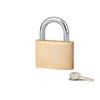Screw Trick Padlocks
In the Slavic areas of Europe (Russia, Serbia, Poland, Czechoslovakia, Slovenia, and so on) the completing padlock for the smokehouse lock was the screw key lock. The screw trick would certainly operate much like you would certainly expect. As opposed to an easy turn, you would certainly have to revolve the trick, threading it right into the lock (comparable to a barrel lock pick). Once the trick had actually been completely screwed the secret would be pulled out (without counter-rotating). This would certainly extend a springtime within the lock, which would certainly withdraw the lock's screw. Yet both of these padlocks saw completion of their appeal by the 1910s when vital variant made the screw vital out-of-date, as well as automation decreased the sales of warded locks.
Scandinavian Padlocks
The road up to obsolescence was led in the 1800s when Swedish creator Christopher Polhem developed what would certainly be known to history as the Scandinavian padlock. The lock body was made up of actors iron, and also the locking device for these padlocks focused around turning disks. The disks need to be rotated, and that was done with grooves on the disks that correspond to a particular key. There were also grooves on the outside of the disks, which would need to be lined up to make sure that the irons could be released. This technology was patented in 1871 and also was continuously made by the license owners up until the 1950s, adding up to practically a century of manufacturing.
Cast Heart Padlock
Just as the smokehouse had the screw trick, so as well did the Scandinavian padlock have the actors heart lock. The actors heart was cast in bronze or brass, which made it really strong, as well as even more resistant to weathering than the Scandinavian padlock. The term "heart" is derived from its shape, which loosely appears like a heart (the valentine's day heart, not the makeup heart). The cast heart would certainly also have a decrease, which was a cover for the keyway that would certainly keep dust and also pests from compromising the lock. It was additionally made for being brought and had a steel loophole so a chain could be placed to secure the lock to your person. These locks could be standardized, which lowered their price and boosted their popularity. They were also a favored among industrial organizations as well as railways because the drop kept dampness as well as crud from eroding or loading the lock, as well as the actors heart can work in icy environments. Some might even state that these locks added in some little component to the appeal of love locks.
Innovations in the Technology
In the 1870s, the cast heart was copied with less expensive products and also the price was decreased once more. The quality of the product had dipped significantly with using secured together metal sheets, as opposed to a solid cast metal body. By the early 20th century, organizations had actually moved from the far more safe actors heart to the stamped and also riveted less costly imitation. As well as while this was taking place Yale was creating the very first modular padlock (up until this factor all padlocks had actually utilized incorporated securing mechanisms). These brand-new modular locking auto mechanics permitted the locks to be serviced and also rekeyed since all parts could be removed as well as rebuilded. This was, nevertheless, almost two decades before Yale would produce the pin and tumbler cartridge that would certainly change the face of security.
The Surge of Electrical Energy as well as Machining
By the beginning of the 1900s the machining procedure was beginning to be much more economically possible, as the accessibility of power was becoming extra prevalent. This was a massive change in the lock making process. It was currently more affordable to make strong metal locks, and the secured lock started to discolor right into the record of history. And with machining making use of the modular locking systems could be conveniently continued. On top of that machining also made it possible to shroud the irons (a body extension that leaves less of the shackle exposed when the padlock is secured) and add an yet an additional layer of safety.
Success and Stumbles
Then in the 20s the Master Lock company launched their padlock as well as the playing field began to take its present form. These locks were not machined yet were rather a return to form for the punched and secured assembly procedure, with the enhancement of a laminated plate that enhanced effect resistance. As well as ultimately in the 1930s die spreading made it basic and economical for molten metal to be cast in a mold and mildew. This presented extra luxuriant and also attractive locks onto the marketplace, however the process had major security defects. Due to the fact that making locks this way jeopardized safety so substantially pass away actors locks have virtually completely vanished from the marketplace.
Final thought
Padlocks have had a long presence as well as survived the ever-changing social landscape. You can still see them anywhere you go even today. However not every lock you connect with is physical. In the existing age, locks have ended up being a symbol of safety. The image of a padlock is made use of possibly extra often than a physical lock. Search almost any kind of website, and appropriate beside the URL there is likely to be a padlock. The safety of an electronic padlock is not something that locksmiths deal with, however it interests see how the concept of safety and security is still synonymous with locks. It is uncertain what the next iteration of security will be, yet it does appear that the padlock might never go away from the globe's collective aware. Whether it is in theory or in practice, the lock appears as if it is here to stay.

评论
发表评论